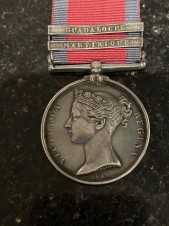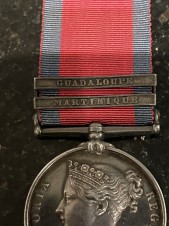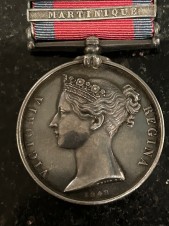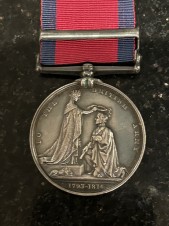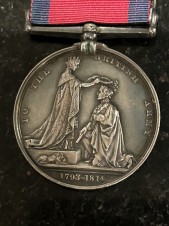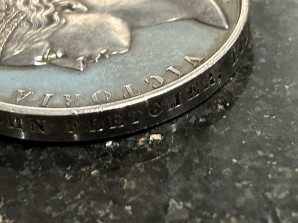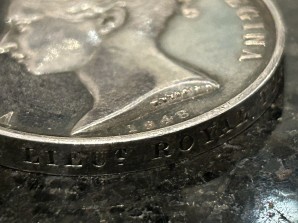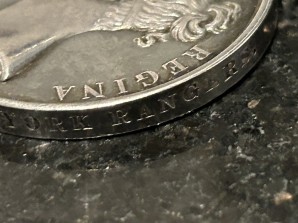AN EXCEPTIONAL & RARE MGS 1793 TO A ROYAL YORK RANGERS LIGHT COMPANY OFFICER
Stock No. 127600
Product Information
Out of Stock
AN EXCEPTIONAL AND RARE MGS 1793 TO A ROYAL YORK RANGERS LIGHT COMPANY OFFICER WHO WAS SEVERAL TIMES WOUNDED DURING HIS SERVICE, INCLUDING AT THE TAKING OF MARTINIQUE IN 1809. HIS COMPANY LEAD A BAYONET CHARGE AT THE TAKING OF GUADALOUPE, THE REGIMENT SUFFERING OVER A THIRD THE NUMBER OF CASUALTIES SUFFERED BY THE ENTIRE ARMY THEY WERE LATER CELEBRATED IN DESPATCHES FOR THEIR GALLANTRY.
MILITARY GENERAL SERVICE 1793,2 CLASPS MARTINIQUE, GUADALOUPE ‘ JOHN FLETCHER, LIEUT. ROYAL YORK RANGERS’
THE ROYAL YORK RANGERS
The Royal York Rangers was formed in 1807 from companies of the Royal African Corps serving in Guernsey. It was primarily composed of condemned men, mostly British and Irish prisoners desperate to escape the gallows. Despite its penal battalion character, it was an extremely effective regiment, receiving praise for is conduct and gallantry during the operations against Martinique and Guadeloupe. At the latter, the Regiment would sustain extremely high casualties whilst assaulting the enemy’s hilltop positions, the taking of which led to the surrender of the French on the Island. With a uniform of green with red facings, they looked not dissimilar to the 60th Rifles who uniform it was based on.
CAPTAIN JOHN FLETCHER
The service of Captain John Fletcher from a book ‘Our Kindred Spirits’, 1995, by G Mitchell which details his family history:
“…Once Commissioned, young John Fletcher set out to gain his own high reputation, especially during service in the British West Indies. Although he was promoted from Cornet
to Lieutenant in the Wagon train on 2nd Jan 1806, he must have found such ancillary troops to tame for his liking. In 1806 the Royal African Corps was converted to Light Infantry Regiments, one being designated the Royal York Rangers a year later. As a keen Subaltern he was able to arrange a transfer to this front line Corps, effective 5th March 1807.
By mid 1808 British troops were being concentrated on Barbados or aboard ships of the Royal Navy, prior to operations against the French held islands of Martinique and Guadeloupe. As the ear ended more troops arrived from Bermuda and Halifax and were organised as two Divisions under the overall command of General Sir George Beckwith. A force of 10,000 men set sail for Martinique on 28th Jan 1809. On the morning of 30th the 2ndDivision landed in force at St Luce, detaching the RYR’s to land at Anse d’Arlet, capture the battery at Cap Salomon and seize the heights commanding Pigeon Island. As the main force pushed inland with little resistance, the Rangers under Major Henderson reached their objectives and the Navy’s Blue jackets, with much labour brought the heavy guns to the heights. By 3rd Feb these guns were able to fire into the fort at Pigeon Island which surrendered the next day,, leaving the entrance to Fort Royal Bay open to the British Fleet.
A month or so after Martiniques capture, a French Squadron sailed into some nearby islands called the Saints. Gen Maitland commanding the 2nd Division was ordered to seize them with a detachment of 2800 men, including the RYR’s Flank Companies. Setting out from Martinique on 12th April, Gen Maitland’s troops forced the surrender of the Saints and returned within a week. That August the Colonel of the RYR, John Fraser (later Gen), wrote to his superior indicating Fletcher’s notable part in these operations:
Although you are well acquainted with Lieutenant Fletcher’s merits as a Regimental
Officer, I think it my duty to state that he was severely wounded in Fort Edward, Martinique, and that I had opportunities there, and at the capture of. Saints, of seeing him under heavy fire conducting himself with the gallantry of a soldier and the judgment of an Officer. He possesses the best qualification for our profession..
Then at the capture of Guadaloupe in February 1810 John’s RYR company led the successful attack. Major Henderson and his two senior captains were wounded, but Fletcher continued unscathed this time. The hilltop action ended with a bayonet charge and with the unit losing 9 Officers and 105 men killed or wounded. The fortress surrendered and citations followed.
John Fletcher was promoted to Captain on 25 August 1811 and the Rangers were withdrawn to Barbados, it seems. Family lore has it that his wife Martha visited the and that daughter Anna was born on Barbados in October 1813. By early 1815 John was detached to Grenada with four companies of the Rangers- normally a Major’s Command. That June he requested six months leave to return to England on his private affairs. Apparently this was his first leave in seven years foreign service! By then peace between Britain and France had been concluded, so his leave was likely extended. In May 1817 we find Lt General Fraser, the Rangers old Colonel, sending a testimonial to “Right Honourable Lord Palmerston, Secretary at War,” in support of John’s request for “compensation on account of wounds received in the West Indies. But with the War ended, the War Minister presumably decided retirement on half pay was in order and effective 9th October that Year John was assigned to the 37th Foot. He continued on half pay with that unit until 1821 when he sought another, more active Regiment and, supported with the plea of Sir Herbert Taylor, soon received a transfer to the 72nd Seaforth Highlanders. He retired from that famed Highland Regiment the next year. His Son Edward explains:
‘Fathers Commission bears the honoured signature of Wellington, shortly after he sold out and entered into some speculation of Peruvian Bonds that turned out badly. The RYR’s were I think something more than a mere Militia Corps; in the West Indies the were always in the thick of the Fray and I recollect seeing in a printed volume of despatches, the statement that on one occasion at Guadeloupe, the conduct of RYR’s was such ‘as to secure the issue of the Campaign…’ in a letter of my Fathers (12th Jul 1847) in which he claimed the medal, then given for WI services, he winds up saying “ From the year 1803 to the end of 1822 I served faithfully as an Officer in the Army. During that period I had long foreign service, was many times in trying situations and received several severe wounds, but with the injuries sustained not being attended with the loss of a limb, I received no pension”. (A doctor Caldwell, later of Montreal, had cared for him when wounded). He certainly did his duty well and when I look at the number of flattering testimonials and letters which he received, I think of his quiet, unostentatious manner and of his many excellencies of mind and heart….”
NOTES TO ABOVE MEMORIAL AND THE TAKING OF GUADALOUPE
Captain John Fletcher Service
Cornet, Royal Wagon Train -25/02/1804
Lieutenant, Royal Wagon Train – 02/01/1806
Lieutenant, Royal York Rangers Flank Company – 05/03/1807 Captain, Royal York Rangers – 25/08/1811
Captain HP, 37th Foot, 9/10/15
Captain HP, 72nd Foot, 1821
Retired 1822
Born in 1779, Captain Fletcher died 1853
In a letter dated 30 September 1817 (copy with research), sent to the Military Secretary, regarding Fletcher’s desire to be removed to a Regiment not service in the West Indies and to be placed on Half Pay, gives a brief description of his service, including the following:
“The memorialist led a Flank Company at the taking of Martinique in February 1809, where he was severely wounded, afterwards at the Saints, and also at the conquest of Guadeloupe, in the years 1810 and 1815”

